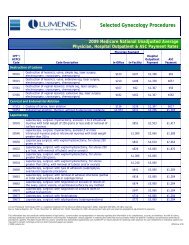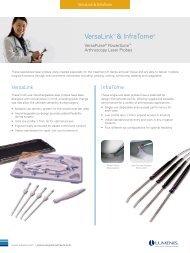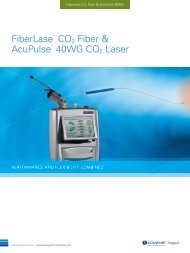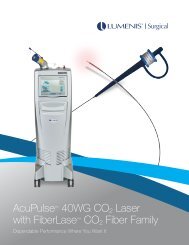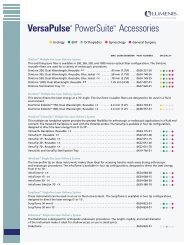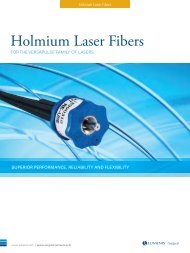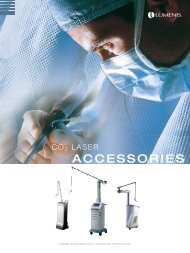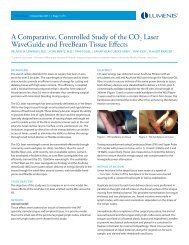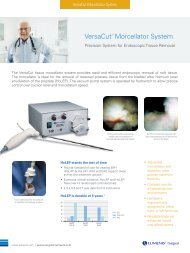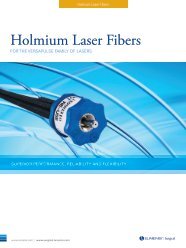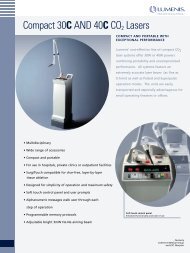HoLAP Technique and Tips - Lumenis Surgical
HoLAP Technique and Tips - Lumenis Surgical
HoLAP Technique and Tips - Lumenis Surgical
Create successful ePaper yourself
Turn your PDF publications into a flip-book with our unique Google optimized e-Paper software.
AUA 2005 | SAN ANTONIO<br />
LUMENIS BOOTH PRESENTATION<br />
<strong>HoLAP</strong> for Beginners<br />
Richard David, MD<br />
Associate Clinical Professor of Urology<br />
David Geffen School of Medicine / UCLA<br />
Los Angeles, CA<br />
Introduction<br />
There are a variety of surgical options available to treat BPH. In general, the more<br />
invasive treatment will result in a better result. The traditional treatments of TURP <strong>and</strong><br />
open simple prostatectomy are complicated by risks of bleeding <strong>and</strong> hospital stays.<br />
Additional risks of impotence, stricture, contracture <strong>and</strong> incontinence also exist.<br />
Holmium laser technology has special characteristics that facilitate endoscopic<br />
urologic surgery. Holmium cuts <strong>and</strong> coagulates simultaneously which allows for a<br />
uniquely bloodless field that reduces the risks of bleeding. The shallow penetration<br />
of holmium limits the necrotic tissue in the prostate minimizing inflammation, scarring<br />
<strong>and</strong> postoperative irritation.<br />
Indications<br />
<strong>HoLAP</strong> can be used for incision <strong>and</strong> ablation of prostate tissue. It is an ideal treatment<br />
for prostatic obstruction from median bar.<br />
Small prostates less than 20 grams are easily treated with incisions. Prostatic<br />
obstruction of larger prostates can be treated with a combination of incision <strong>and</strong><br />
ablation of the lateral lobes. The larger the prostate, the longer the procedure lasts.<br />
Prostates can also be treated very effectively with HoLEP, but this technique is not<br />
addressed here.<br />
<strong>Surgical</strong> <strong>Technique</strong><br />
Equipment used is a continuous flow scope with a laser bridge. The fiber used<br />
is the DuoTome side-firing fiber that emits laser energy at 70 degrees forward.<br />
Higher energy is preferable <strong>and</strong> a rapid repetition rate leaves a smoother cavity.<br />
The VersaPulse ® PowerSuite 100 Watt laser is used with settings of 2.0 J at<br />
50 Hz. Water or saline can be used for irrigation.<br />
After introduction of the scope, incisions are made at 5 <strong>and</strong> 7 o'clock. If needed,<br />
a third incision can be made at 12 o'clock. The fiber is passed across the area to<br />
be incised. Laser energy is discharged as the fiber is withdrawn slowly (l mm/sec).<br />
The DuoTome is rotated as it is withdrawn to vaporize a trough. Repeated passes<br />
are made until the desired depth is reached.<br />
After the incisions, placing the fiber in contact or near contact directly ablates<br />
obstructing lateral lobe tissue. The lateral lobe tissue in the path of the laser melts<br />
away. Once the surgical capsule is reached the procedure is completed.<br />
Postoperative Care<br />
Catheter placement is optional. A catheter is placed in patients who have large<br />
residuals or pre-existing bladder dysfunction. A Foley catheter is also placed in<br />
patients who have had spinal or epidural anesthesia. The catheter is removed in<br />
a few hours prior to discharge from the outpatient unit or the next morning.<br />
<strong>HoLAP</strong> vs TURP<br />
• Similar symptomatic improvement but very little bleeding <strong>and</strong> no transfusions.<br />
• Shorter catheter time <strong>and</strong> hospital stay.<br />
• Can treat anticoagulated patients while they are anticoagulated.<br />
Holmium vs KTP<br />
• KTP penetrates deeper, leaving necrotic tissue that can cause postoperative<br />
irritative voiding symptoms.<br />
• It is harder to vaporize tissue as it becomes desiccated with KTP, slowing the<br />
procedure down over time.<br />
LUMENIS BOOTH 968<br />
Conclusion<br />
<strong>HoLAP</strong> is an easy to learn procedure that provides excellent surgical results<br />
comparable to TURP in an outpatient setting with few complications.



